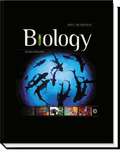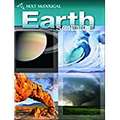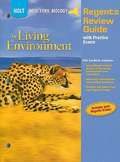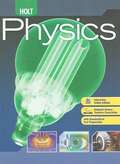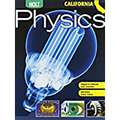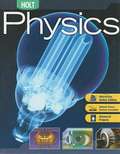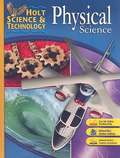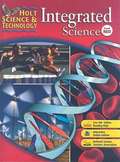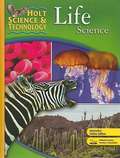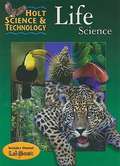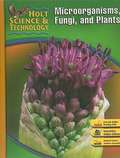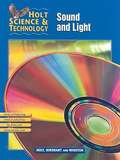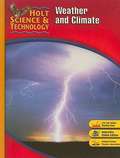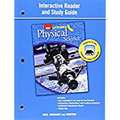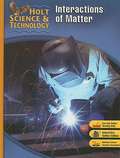- Table View
- List View
Holt Mcdougal Earth Science
by Holt Mcdougal Allison Holt McDougalHolt Mcdougal Earth Science: Student Edition 2010
Holt New York Biology: Regents Review Guide With Practice Exams
by Holt Rinehart WinstonBiology textbook for New York students, with review guide and practice exams.
Holt Physics
by Raymond A. Serway Jerry S. FaughnThis book touches on a lot of material, including basic collisions, fluids, rotational motion, relativity, and even some quantum mechanics.
Holt Physics
by Raymond A. Serway Jerry S. FaughnThis textbook contains chapters on The Science of Physics, Motion in One and Two Dimensions, Forces and the Laws of Motion, Work and Energy, Momentum and Collisions, Rotational Motion and the Law of Gravity, Rotational Equilibrium and Dynamics, Fluid Mechanics, Heat, Thermodynamics, Vibrations and Waves, Sound, Light and Reflection, Refraction, Interference and Diffraction, Electric Forces and Fields, Electrical Energy and Capacitance, Current and Resistance, Circuits and Circuit Elements, etc.
Holt Physics
by Raymond A. Serway Jerry S. FaughnHolt Physics is useful especially to beginners as an introduction to advanced Physics.
Holt Science & Technology, Physical Science
by Christie Borgford Andrew Champagne Mapi CuevasNIMAC-sourced textbook
Holt Science & Technology: Environmental Science
by Holt Rinehart WinstonThis book was created to make students' science experience interesting, exciting, and fun!
Holt Science & Technology: Human Body Systems and Health, Interactive Textbook
by Holt Rinehart WinstonNIMAC-sourced textbook
Holt Science & Technology: Inside the Restless Earth, Interactive Textbook
by Holt Rinehart WinstonNIMAC-sourced textbook
Holt Science & Technology: Integrated Science Level Red
by Holt Rinehart WinstonNIMAC-sourced textbook
Holt Science & Technology: Interactions of Matter
by Christie Borgford Sally Ann VonderbrinkThe book elaborates on interactions of matter with relevant topics like chemical bonding, reactions, compounds etc with useful additions like pre-reading and test preparation activity.
Holt Science & Technology: Life Science (California Edition)
by Holt Rinehart WinstonLife science is the study of living things--from the tiniest bacterium to the largest tree! In this unit, you will discover the similarities of all living things.
Holt Science & Technology: Life Science (Grade #6)
by Robert W. Todd David F. Bowman Laura Zapanta Bill Burnside Charlotte Luongo Kelly RizkLife science is the study of living things--from the tiniest bacterium to the largest tree! In this unit, you will discover the similarities of all living things. You will learn about the tools life scientists use, and you'll learn to ask your own questions about the living world around you. People have always searched for answers about life. This time- line includes a few of the many people who have studied living things through the centuries. And there's always more to be learned, so keep your eyes open.
Holt Science & Technology: Microorganisms, Fungi, and Plants
by Katy Z. Allen Linda R. BergEach chapter of this book contains reviews, test preparations and experiment instructions.
Holt Science & Technology: Sound and Light
by Holt Rinehart WinstonThis book was created to make the science experience interesting, exciting, and fun to students.
Holt Science & Technology: The Earth's Surface
by Holt Rinehart Winston Staff7th grade science textbook
Holt Science & Technology: Weather and Climate
by Robert J. Sager Kathleen KaskaScience textbook on understanding the atmosphere, the weather, and the climate.
Holt Science And Technology California Interactive Reader Study Guide Grade 8 Physical Science
by Hrw StaffA physical science study guide book.
Holt Science And Technology: Human Body Systems and Health
by Holt Winston RinehartMiddle School Science Textbook
Holt Science And Technology: Interactions Of Matter Short Course L
by Holt Rinehart Winston Holt Rinehart WinstonA Reading Strategy at the beginning of every section provides tips to help you organize and remember the information covered in the section. Keep a science notebook so that you are ready to take notes when your teacher reviews the material in class. Keep your assignments in this notebook so that you can review them when studying for the chapter test.
